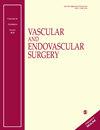Endovascular Treatment of Aortoiliac Aneurysms With the Bell-Bottom Technique: A Systematic Review and Meta-Analysis
IF 0.7
4区 医学
Q4 PERIPHERAL VASCULAR DISEASE
引用次数: 0
Abstract
ObjectiveAneurysmal degeneration of the common iliac artery (CIA) can pose a challenge to achieve distal landing zone sealing at the time of endovascular abdominal aortic aneurysm repair (EVAR). The aim of this study was to summarize the current literature regarding the bell-bottom technique (BBT) for ectatic CIAs during EVAR.MethodsThis study was performed according to the Preferred Reporting Items for Systematic Reviews and Meta-analyses (PRISMA) guidelines. Eligible articles were identified through a comprehensive search of PubMed, Scopus, and Cochrane Central published until April 2023. A meta-analysis was conducted using the random effects model and the I用钟罩底技术进行主动脉髂动脉瘤的血管内治疗:系统回顾与元分析
目的髂总动脉(CIA)的动脉瘤变性会给血管内腹主动脉瘤修补术(EVAR)时实现远端着床区密封带来挑战。本研究旨在总结目前有关EVAR期间钟底技术(BBT)治疗异位CIA的文献。通过对截至 2023 年 4 月出版的 PubMed、Scopus 和 Cochrane Central 进行全面检索,确定了符合条件的文章。采用随机效应模型进行荟萃分析,并使用 I2 统计量评估异质性。主要终点为Ib/III型内漏、移植物闭塞/肢体栓塞和再介入率。次要终点包括围手术期不良事件和死亡率。结果共纳入了 26 项研究和 4332 例扩创肢体患者。Ib/III型内漏的汇总估计值为4%(95% CI:2-6,I2=85.6%),再介入率为9%(95% CI:6-12,I2=90.4%),总死亡率为10%(95% CI:4-19,I2=97.3%)。没有与动脉瘤相关的死亡记录。比较分析显示,EVAR BBT组、髂支内膜假体组(IBE)和髂内动脉栓塞后将髂肢延伸至髂外动脉组(EIE)之间的Ib/III型内漏、移植物闭塞和再介入率相似。结论对于有CIA异位的EVAR病例,使用外展髂肢可被视为合理的一线选择,因为这种方法更简单,允许将来使用IBE或EIE,而且不会增加Ib/III型内漏或移植物闭塞的风险。还需要进行更长时间的随访比较研究。
本文章由计算机程序翻译,如有差异,请以英文原文为准。
求助全文
约1分钟内获得全文
求助全文
来源期刊

Vascular and Endovascular Surgery
SURGERY-PERIPHERAL VASCULAR DISEASE
CiteScore
1.70
自引率
11.10%
发文量
132
审稿时长
4-8 weeks
期刊介绍:
Vascular and Endovascular Surgery (VES) is a peer-reviewed journal that publishes information to guide vascular specialists in endovascular, surgical, and medical treatment of vascular disease. VES contains original scientific articles on vascular intervention, including new endovascular therapies for peripheral artery, aneurysm, carotid, and venous conditions. This journal is a member of the Committee on Publication Ethics (COPE).
 求助内容:
求助内容: 应助结果提醒方式:
应助结果提醒方式:


